
WTF Taekwondo is associated with Korea's Kukkiwon.

The WTF logo
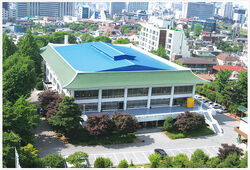
The Kukkiwon main building in the affluent Gangnam district of Seoul, South Korea
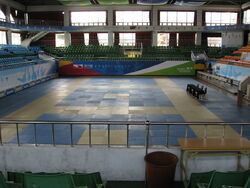
Close-up of the main stadium
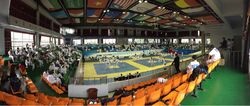
A panorama of the main stadium
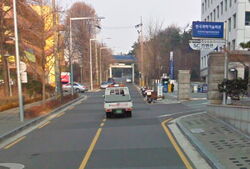
You can take a virtual drive into the Kukkiwon entrance using Google Street View: http://www.google.com/maps/@37.5001983,127.0305548,3a,75y,346.38h,80.98t/data=!3m4!1e1!3m2!1s0XgtNDVmVC3FinmcR4Gk-w!2e0
The Kukkiwon (국기원; 國技院) is the style-defining organization for the style of taekwondo known as Kukkiwon-, Olympic-, or WTF-style taekwondo. For people who practice this style of taekwondo, the Kukkiwon is the organization that issues dan (black belt) certificates and ID cards. To compete in national-level and international tournaments sponsored by the World Taekwondo Federation, generally speaking one must hold a Kukkiwon-issued dan certificate. Until the signing of the Protocol of Accord in August 2014, a person had to hold a black belt certificate issued by the Kukkiwon in to compete in the Olympic games.
Colloquially, terms "Kukkiwon" and "World Taekwondo " (WT) are used almost interchangeably, though technically they are entirely separate bodies. The Kukkiwon is a government-sponsored national academy for taekwondo, while the WT is the international sports federation for Kukkiwon-style taekwondo. Both being headquartered in Seoul, however, it is not uncommon for the two organizations to collaborate closely. For a short time in the early 1970s, the WT issued its own dan certificates as well (essentially equivalent to Kukkiwon-issued dan certificates), though this practice was eventually stopped.
Both the building itself and the organization therein are colloquially referred to as the Kukkiwon. The Kukkiwon is the official governing body established by the South Korean government for taekwondo; the Kukkiwon is supervised by the International Sports Division within the South Korean Ministry for Culture, Sports, and Tourism. The word Kukkiwon literally means "national academy".
The Kukkiwon is also known as World Taekwondo Headquarters; it is the home of the World Taekwondo Academy (WTA). The WTA is responsible for maintaining the Kukkiwon-style curriculum, promoting taekwondo education, training taekwondo instructors, and performing research related to taekwondo.
History[]
By the late 1960s there were already several different styles of taekwondo being practiced worldwide. The Korea Taekwondo Association (KTA) was charted by the South Korean government to consolidate and unify the styles of taekwondo then being practiced in South Korea by the various kwans, or schools. Even before the construction of the Kukkiwon was undertaken, this style was being referred to as the "national-" or "kukki-" style.
In 1967 Yong Chae Kim (of the Kang Duk Won) became the 5th president of the KTA since its re-establishment in 1961. Kim served in this role until 1971. Kim is credited as having been the driving force behind the development of the Kukkiwon, especially in terms of petitioning for government funds for the construction of the physical facility. In that same year, the KTA completed development of the Palgwae and Yudanja taekwondo forms, which became the original basis for kukki-style taekwondo.
In 1971 Dr. Un Young Kim (a former assistant director of the Korean CIA) was elected 6th president of the KTA. Though Yong Chae Kim (his predecessor) was responsible for most of the lobbying for funds for building the Kukkiwon, the Kukkiwon was finalized during the tenure of Un Young, who continued Yon Chae's drive for its establishment. That same year, South Korean President Chung Hee Park announced that taekwondo would become the national sport of Korea; at the same time he allocated funds for the completion of the Kukkiwon. Once completed, the Kukkiwon took over many of the style-defining functions previously served by the KTA; the KTA itself continued to work toward kwan consolidation. Also in 1971, the Jidokwan and Moo Duk Kwan agreed to operate under the KTA/Kukkiwon banner, and the Palgwae taekwondo forms were replaced with the newer Taegeuk forms for kukki-style taekwondo.
On 30 November 1972, construction of the Kukkiwon was completed. By the mid 2000s Kukkiwon-style taekwondo had grown to such an extent that the physical facility of the Kukkiwon was no longer large enough to support all the activities chartered by the organization. In 2007 construction of the Taekwondowon ("Taekwondo Park") was undertaken, about 3 hours south of Seoul in Muju, to essentially serve as a larger annex to the Kukkiwon for taekwondo training. (See also: Taekwondo Promotion Foundation and Taekwondowon.)
Timeline[]
- 1971, November 19 - Ground-breaking ceremony for the Kukkiwon
- 1972, November 30 - Kukkiwon completion ceremony
- 1973 - Un Yong Kim appointed first President of Kukkiwon. He held this position until his resignation on 15 November 2001.
- 1973, February 6 - the name "Kukkiwon" finalized
- 1973, February 24 - Kukkiwon publishes "Taekwondo Manual"
- 1973, April 5 - Kukkiwon holds its first promition test for high-level dan holders
- 1973, May 28 - The World Taekwondo Federation (WTF) established
- 1974, September 6 - Kukkiwon Demonstration Team established
- 1975, February 14 - The term "poom" (rather than "dan") established to denote black-belt holders under age 15
- 1982, November 30 - South Korean government formally designates Kukkiwon as the official training institute for taekwondo
- 1987, November 30 - "Taekwondo Manual" updated and renamed Taekwondo Textbook
- 1995, September 20 - Publication of English-language version of Taekwondo Textbook
- 2004, March 2 - Woon Kyu Uhm of the Chung Do Kwan elected new President of the Kukkiwon.
- 2005, late - Yong Gye Um elected president of the Kukkiwon.
- 2006, April 3 - Taekwondo Research Institute established within the Kukkiwon
- 2009, December 10 - Lee Seung Wan of Jidokwan elected Kukkiwon Chairman of the Board.
- 2010, January 6 - Lee Seung Wan appointed Kukkiwon President
- 2010, February 23 - Park Chang Dal appointed Kukkiwon Chairman of the Board
- 2010, May 20 - Kim Joo Hoon appointed Kukkiwon Chairman of the Board
- 2010, June 4 - Kang Won Sik of Song Moo Kwan appointed Kukkiwon President
- 2012, February - Publication of updated Taekwondo Textbook
- 2013, early - Won Sik Kang steps down as President of Kukkiwon. Kyu Sok Lee is appointed interim president while a new president is sought. Kyu Sok Lee also serves as Secretary General for the Asian Taekwondo Union.
- 2013, June 17 - Hong Moon Jong appointed Kukkwon Chairman of the Board
- 2013, October 27 - Lee Kyu Hung appointed Kukkiwon President after being provisionally named by the Chairman of the organization’s board on August 20, 2013. Lee resigned shortly after accepting the position however, citing internal politics at a roadblock which would prevent him from being effective.
- 2014, February 6 - Jung Man Soon appointed Kukkiwon President. Soon was a professor of Taekwondo and former dean of Chungju University.
- 2014, February 20 - Oh Hyeon Deuk appointed Kukkiwon Vice President
- 2016, June 3 - Oh Hyeon Deuk appointed Kukkiwon President
Physical Facilities[]

Kukkiwon campus
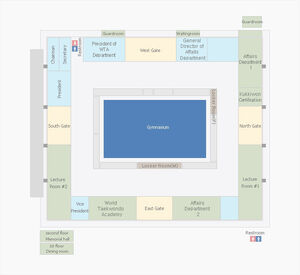
Floor plan of the Kukkiwon main building
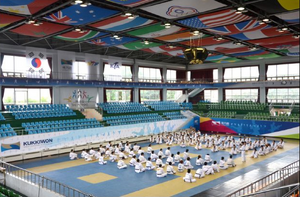
The Kukkiwon main stadium
The main building of the Kukkiwon accommodates up to 3,000 people for events. Standing at three stories in height, the building's roof features kiwa (blue Korean tiles), the same type of roofing as the Blue House (the official residence of the President of South Korea). The style of the architecture is intended to evoke traditional Korean architecture.
The Kukkiwon facility includes:
- the main stadium
- locker rooms with showers
- a medical clinic for sports injuries
- a pavilion (palgakjeong)
- a board room
- two classrooms
- management offices
- a restaurant
- and a museum (see below)
For more information, see Kukkiwon on Wikipedia or read the main article WTF Taekwondo.
Kukkiwon Museum[]
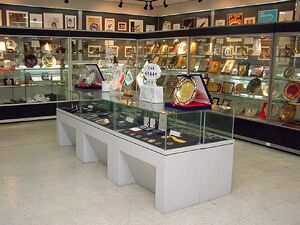
The Kukkiwon Museum
The Kukkiwon's Taekwondo Memorial Hall museum is located on the second floor of Kukkiwon auxiliary building and boasts an exhibition room and a data library. Inside the museum are are historical records of taekwondo and as many 2,500 commemorative items on display, such as taekwondo Dobok (uniform), Hogu (chest protector), various Gyeorugi (sparring) equipment, trophies from major competitions, plaques, championship flags, badges, pendants, photographs, books, newspaper and magazine articles, and audio-visual clips. There are 360 photographs and posters, 40 trophies, 155 medals, 147 plaques, 270 souvenirs, 400 films and videotapes in the museum. Publications on display include 171 taekwondo-related periodicals, 58 newspaper articles, and 355 books on taekwondo.
Kukkiwon at the Google Cultural Institute[]
The Google Cultural Institute is a collection of webpages that contain high-resolution images and videos of works of art, world wonders, historic moments, and performing arts. In the category of performing arts, the Google Cultural Institute has developed an exhibit for the Kukkiwon. The website for this exhibit can be found at https://www.google.com/culturalinstitute/collection/kukkiwon?projectId=performing-arts&v.view=grid
See Also[]
References[]
- Kukkiwon on the Korean version of Wikipedia http://ko.wikipedia.org/wiki/국기원 (use Chrome browser or Google Translate to read in English)
- Kukkiwon Memorial Hall website
- Kukkiwon dojang-finder and poom/dan count: http://kms.kukkiwon.or.kr/usr/main.do
| This page uses Creative Commons Licensed content from Wikipedia (view authors). |